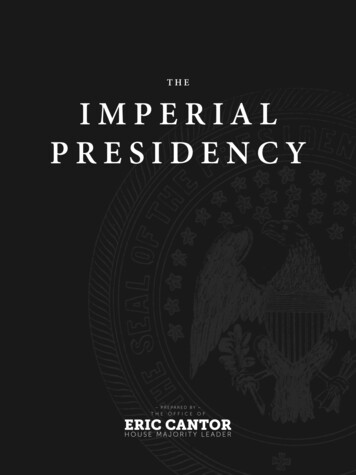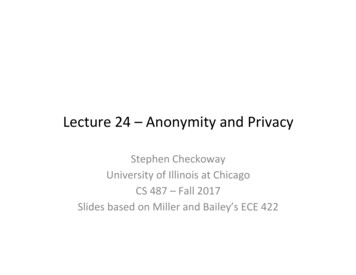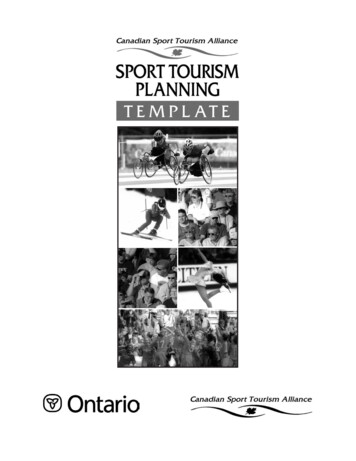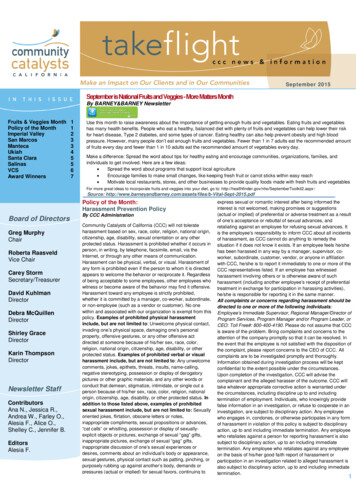
Transcription
THEIMPERIALPRESIDENCY– PREPARED BY –THEOFFICEOF
THEIMPERIALPRESIDENCYIMPLICATIONS FORECONOMIC GROWTH& JOB CREATIONEC
THEIMPERIALPRESIDENCYOver the past several months opinion pieces appearing in such places as TheWashington Post, National Review, and The Wall Street Journal have talkedabout the emergence of an “Imperial Presidency.” While some may wish to simplychalk this up to partisan criticism of the incumbent President, even The New YorkTimes in a recent A1 article examined “an increasingly deliberate pattern by the administration to circumvent lawmakers ”Less noticed, but perhaps even more important – especially to the over 20million Americans currently out of work or underemployed – is the link between abreakdown in the rule of law and reduced economic growth and individual prosperity.Property rights and rule of law are essential for the proper and efficient functioning of society and the economy. Unambiguous laws and procedures provide aframework by which free people agree on the scope and reach of their government’sactions, whereas unclear laws or arbitrary enforcement undermine individual libertyand the notion of popular sovereignty. Clear, transparent, predictable rules that areapplied without preference or prejudice allow individuals to invest, build businesses,and create jobs. When there is a breakdown in the rule of law, increased uncertaintyleads to reduced investment and less growth.Numerous economic studies have documented the relationship between astrong rule of law and economic growth. In 2008, The Economist published the following chart alongside a story entitled “Order in the Jungle.” The chart aptly illustrates the strong relationship between adherence to the rule of law and economicgrowth. As economist Hernando de Soto – a leader in the field of the impact ofproperty rights and rule of law on economic growth succinctly stated: “So the originThe Imperial Presidency 1
of the rule of law— which will allow a modern nation to grow and so bring peace, stability, and prosperity to the world—is propertyrights. And the rule of law will actually generate prosperity.”In the United States, the ultimate law isthe Constitution, which specifically provideshow laws are to be enacted and requires thePresident to take care that the laws that are enacted are faithfully executed. The laws of theUnited States establish the process whereby individuals can enforce their property rights andprivate contracts and provide the frameworkby which executive agencies are to conduct rulemakings and the other regulatory activities.When “laws” are created without going through Congress; when laws areselectively executed; when an administration intervenes into the normal judicialprocess and diminishes an individual’s property rights; and when the normalregulatory process is circumvented, the rule of law is eroded.All of this increases uncertainty. Individuals, families, and businesses nownot only face uncertainty with respect to the policy decisions made by government, but they face uncertainty as to how those decisions will even be made, Numerous economic studies and surveys indicate that uncertainty itself (which iscertainly increased with the breakdown in the rule of law) also hinders economicgrowth.While Administrations of both political parties have been known to testthe bounds of the limits of their power, the breadth of the breakdown in therule of law in recent years has reached new levels. In the Heritage Foundationand Wall Street Journal’s annual Index of Economic Freedom, the United Statesscores lower today on the rule of law than it did in 2008. As the 2012 report notes,“Corruption is a growing concern as the cronyism and economic rent-seekingThe Imperial Presidency 2
associated with the growth of government have undermined institutional integrity.” Individuals and businesses are increasingly forced to rely on the courts toenforce their most basic substantive and procedural rights.Over the past year-and-half, the Committees of the House of Representatives have investigated and documented numerous break-downs in the rule of law.This report compiles over 40 separate examples that span the breadth of government, including instances where the Administration has attempted to: Tell a private business in what state it can locate; Tell a religious institution which employees are “religious” under certainfederal laws; Regulate the internet; Rewrite Federal education law; Created new “Super” regulatory agencies; and Significantly restrict America’s energy resources.The Imperial Presidency 3
IGNORINGADVISE & CONSENTOne of the checks and balances imposed by the Founding Fathers was therequirement that senior Executive Branch officials be appointed only with the consent of the Senate. In the modern regulatory state the approval of officials by theSenate is one key way to ensure that regulators do not abuse their authority. Inorder to address situations where the Senate was in recess, thus preventing themfrom consenting, the Founders provided for a limited interim appointment process absent Senate confirmation.“Recess” AppointmentsWhen the Senate did not approve four of his nominees to two regulatoryagencies – the head of the new Consumer Financial Protection Bureau (CFPB)and three members of the National Labor Relations Board (NLRB) – PresidentObama took the unprecedented step of declaring that the Senate was in recess –even though it wasn’t – and invoking his interim appointments power.Seating the head of the CFPB and a quorum for the NLRB allowed both agencies to begin promulgating regulations that would have otherwise have been onhold until the President and the Senate came to agreement on filling the vacancies.The President’s unconstitutional acts are now the subject of pending litigation by those negatively impacted by the new rules and determinations publishedby these agencies.Ignoring Advise & Consent 4
C R E AT I N G“ L AW S ” O U T S I D E O FTHE C ONGRESSIONALPROCESSFor decades, Congress under both parties authorized and permitted federalagencies to exercise immense control over the economy through the rulemakingprocess. For the regulated, there is virtually no difference between a legal requirement imposed by statute and a legal requirement imposed by regulation. But bothparties have always agreed that agency action is limited to the authority granted tothe agency by an Act of Congress, duly signed by the President. Under this simplelimitation, at least some limits are imposed on the unelected officials who run theagencies. Under the Obama Administration, agencies have gone further than everbefore in overturning decades of regulatory precedent, acting without statutoryauthorization, and otherwise abusing the rulemaking process to create de factolaws without going through Congress.Changing the Unionization Process Majority Threshold: In 2009, the President’s appointees to the National Mediation Board (NMB) changed union election rules that had been in placefor 75 years under the Railway Labor Act so that union certification required only a majority of the employees who vote in the election (as opposed to the majority of all employees). This change made it easier to forma union. But, the NMB conveniently left in place the arduous process underthe Railway Labor Act to decertify a union. Congress ultimately respondedwith provisions included in the FAA Modernization and Reform Act (P.L.112-95) to address the President’s changes by requiring: (1) Any new NMBrulemakings be subject to public hearings; (2) Elections to either unionizeCreating "Laws" Outside Of The Congressional Process 5
or vote out a union are conducted on an equal footing; and (3) GAO toconduct regular and substantive oversight of the NMB, which the Board haspreviously lacked. Ambush Elections: In June 2011, the National Labor Relations Board(NLRB) proposed sweeping changes to the rules governing union elections.Under the proposal, union elections could take place in as little as 10 days,restricting an employer’s right to communicate with his or her employeesand undermining workers’ ability to make an informed decision. This pastMay a federal judge overturned the NLRB regulation citing that the agencylacked the legal quorum necessary when it approved the measure. Creating Micro-Unions: In August of 2011, the NLRB discarded decades ofprecedent in order to adopt a biased standard for determining which groupor “unit” of employees can vote in a union election. Union leaders have longtried to organize smaller units of employees as an incremental step towardorganizing an entire business. In an effort to preserve unity in the workplace and keep labor costs low, employers often seek to expand the unit toinclude a greater number of employees. Under the board’s new standard, itwill be virtually impossible for employers to challenge the group of employees handpicked by the union. The new standard empowers union leadersto manipulate workplaces for their own gain, with dramatic consequencesin the real world. Affected employers will be constantly engaged in costlylabor disputes. For example, a grocer could be negotiating one day with hiscashiers and the next with those who stock the shelves.In November of 2011, in response to these harmful Obama Administrationregulations and edicts, the House passed the Workforce Democracy and FairnessAct.Creating "Laws" Outside Of The Congressional Process 6
Telling Businesses Where They Are Allowed to LocateChoosing where to set up shop and hire workers is a fundamental businessdecision. Bureaucrats at the National Labor Relations Board (NLRB) believe theyshould have a say in that decision. In April of 2011, the NLRB filed a complaintagainst The Boeing Company for building an assembly line in South Carolinadespite the fact the NLRB could not demonstrate that Boeing was breaking anylaw. The NLRB tried to force Boeing to move the work to Washington State fromthe non-union facility in South Carolina. Ultimately the NLRB backed down anddropped their case against Boeing, only after their coercive efforts caused Boeingto modify its agreement with a Washington-based union.In September of 2011, in response to the NLRB, the House passed the Protecting Jobs from Government Interference Act.Imposing “Propaganda” Mandates on EmployersDespite the fact that Congress has never provided the National Labor Relations Board (NLRB) with the authority to require employers to provide general notice posting in the workplace, last year the NLRB finalized a new rule that requiresnearly every private employer to post in the workplace a vague and biased noticeof employee “rights.” What the poster really represents is a marketing campaignby Big Labor mandated by its allies at the NLRB. This new unfunded mandate onbusiness is currently the subject of litigation.Telling Federal Contractors Who They Have to HireShortly after taking office, President Obama issued an Executive Order thatwould limit employer flexibility and increase costs by forcing federal contractorsthat perform services previously performed by another contractor to offer jobsto the predecessor’s employees. While Congress had previously legislated issuesrelated to successor contractors, Congress never required or even authorized theimposition of this new mandate on whom private employers are required to hire.Creating "Laws" Outside Of The Congressional Process 7
Regulation of Hydraulic FracturingThe states have always had primacy to regulate oil and gas activity, including hydraulic fracturing, on state and private lands. This relatively new technology represents the largest area of growth towards American energy independence.With respect to hydraulic fracturing specifically, the federal government expresslycodified this primacy, leaving the EPA with limited authority to regulate fracturing. The Agency, in a March 2011 letter to Senator Cardin, admits that “EPA’s authority to regulate or respond to natural gas exploration and production activitiesis limited by exemptions established under several of the principal environmentalstatutes we administer.”EPA seems undaunted by this admitted lack of Congressionally-granted authority, and instead is looking for ways to overcome this limitation without Congressional consent. To this end, EPA’s Office of Science Policy within the Officeof Research and Development (ORD) recently stated that the Agency is doing “apretty comprehensive look at all the statutes” to determine where “holes” may allow for additional oversight or regulation.In response, several House Committees held hearings to examine the negative impact that will result from the Obama Administration’s regulation of hydraulic fracturing on energy development, job creation and economic growth.Establishing a National Ocean Regulatory PolicyOn July 19th, 2010 President Obama signed Executive Order 13547 to adoptthe final recommendations of the Interagency Ocean Policy Task Force to implement a new National Ocean Policy, which includes a mandatory Coastal and Marine Spatial Planning initiative to “zone” the oceans. In this unilateral action, heestablished a top-down, Washington, D.C.–based approval process that will hinder rather than promote ocean and inland activities and cost American jobs.Without clear statutory authority, the policy sets up a new level of federal bureaucracy with control over the way inland, ocean and coastal activities aremanaged. This has the potential to inflict damage across a spectrum of sectors in-Creating "Laws" Outside Of The Congressional Process 8
cluding agriculture, fishing, construction, manufacturing, mining, oil and naturalgas, renewable energy, and marine commerce, among others. The Administrationtook this action despite the fact that in four separate Congresses, legislation hasbeen introduced to implement similar far-reaching ocean policies, and to-date NObill has passed the House or even been reported out of a Committee.The House Natural Resources Committee held several hearings to examinethe President’s National Ocean Policy.Creating a New Land Regulation ProgramIn 2010, Secretary of the Interior Ken Salazar announced a “Wild Lands”Secretarial Order. This new Wild Lands policy would effectively allow the Administration to circumvent the strictly congressional authority of designating wilderness areas. By treating these new Wild lands as de facto wilderness, millionsof acres of public land could be placed off-limits from their original multi-usepurpose. Congress ultimately stepped in and prohibited the Department of theInterior from using funds to carry-out this policy.Global Warming RegulationsThe Obama Administration’s EPA is developing global warming regulationsthat have the potential to be the most complex, far-reaching, and expensive in theagency’s history.At a November 2010 White House Press Conference, President Obama saidof Congress’ rejection of a cap-and-trade bill, “cap-and-trade was just one way ofskinning the cat, it was not the only way. It was a means, not an end. And I’m goingto be looking for other means .”The Obama Administration is using the regulatory process to “skin the cat,”implementing major aspects of the 2009 cap-and-tax legislation despite the factthat it was rejected by Congress.Creating "Laws" Outside Of The Congressional Process 9
Network Neutrality RegulationsIn recent years technology has been one of our nation’s strongest economicgrowth areas, yet the Federal Communications Commission (FCC) has soughtto impose new network neutrality rules on the internet. In 2010, a Federal courtstruck down the FCC’s first attempt to regulate the internet; noting that the FCClacked authority to issue such regulations. Then-Energy & Commerce CommitteeChairman Henry Waxman (D-Calif.) introduced legislation to provide such authority. Despite the fact that the legislation was not enacted, the FCC proceededanyway with new net neutrality rules. Businesses negatively impacted by thesenew regulations have been forced to go to court once again to defend against regulations that the agency has no authority to issue.In April, the House passed a Resolution of Disapproval, H. J. Res. 37, tooverturn the FCC’s controversial internet rules that stifle small business growthand investment in order to promote freedom and innovation.Auto Efficiency MandateThe Obama Administration is imposing costly vehicle efficiency standardsmore than a decade into the future under the regulatory auspices of an agency notauthorized to establish such standards. Congress set up the CAFE program in the1974 Energy Policy and Conservation Act (EPCA), but the Administration’s ruleviolates most of that statute’s key provisions. Regulatory Agency: It is clear that Congress wanted the National HighwayTraffic Safety Administration (NHTSA) to be the sole federal agency settingthese standards, and that states were preempted from going their own way.Yet the Obama administration has given EPA the lead role and has allowedCalifornia to wield significant influence, in effect allowing California to dic-Creating "Laws" Outside Of The Congressional Process 10
tate an auto standard for all other states. Under this administration’s rules,NHTSA is a decidedly junior partner despite being the only one with anyexpertise on fuel economy standards. Stringency and Regulatory Timeline: The stringency of the rule, 54.5 mpgby 2025, goes far beyond what Congress envisioned when it last spoke on thematter in the 2007 energy bill. The fact that standards are being locked in allthe way out to model year 2025 is something Congress never authorized. Cost: EPA concedes that its mandate will cause sticker prices to rise 3,000by 2025, while the National Association of Auto Dealers predicts even higher vehicle cost increases – this arguably violates NHTSA’s obligation underEPCA to take economics into account. Vehicle Safety: There is no indication that the 54.5 mpg by 2025 mandatehas taken into consideration vehicle safety concerns, despite the fact thatsafety is a statutory requirement in establishing such standards.Several House Committees have held hearings to examine fuel economystandards for light and heavy duty vehicles, and the Obama Administration’s recent agreement to raise fuel economy standards for model years 2017-2025.Claiming the Power to Define What ConstitutesReligious EmploymentThe Administration’s Equal Employment Opportunity Commission(EEOC) took the position that the Administration has the power to declare whatreligious staff positions at a religious institution are “religious enough” to enjoy theprotections from government interference guaranteed by the First Amendment.Ultimately, the Supreme Court decided 9-0 against the Obama Administration’sposition. Even President Obama’s two Supreme Court appointees found the Administration’s position untenable.Creating "Laws" Outside Of The Congressional Process 11
Draconian Regulation of CoalThe Clean Air Act’s “Good Neighbor” provision gives the EPA the authorityto reduce interstate pollution that interferes with the attainment and maintenanceof the national ambient air quality standards protecting public health. A previousregulation coordinated states’ implementation plans addressing interstate pollution, but that regulation was remanded by the court for further analysis. Underthe guise of responding to that court remand, the Obama EPA misused the GoodNeighbor provision to impose more stringent emissions reductions under federalimplementation plans in the Cross-State Air Pollution Rule (“CSAPR”). CSAPRwas a thinly veiled attempt to impose such draconian reductions on coal-firedpower that the only option for some was a shutdown of electric generation plantsand a loss of jobs at coal mining operations. In an August 2012 decision vacatingEPA’s “Cross-State Air Pollution Rule,” the D.C. Circuit Court of Appeals stated thefollowing---, “EPA has transgressed statutory boundaries.” “EPA pursues its reading of the statutory text down the rabbit hole to a wonderland where EPA defines its target after the States’ chance to comply withthe target has passed.” “EPA’s authority to issue these [Federal Implementation Plans] rests on ouraccepting its rickety statutory logic. We decline the invitation.”Creating "Laws" Outside Of The Congressional Process 12
IGNORINGLETTER OFFA I L I N G T OEXECUTETHE PLAINT H E L AW &FA I T H F U L LYT H E L AWThe President is charged under the Constitution with ensuring that the laws– all laws – are faithfully executed. That means comporting regulatory proposalsto the requirements of statute and carrying out the law as it is written, not as thePresident may wish that it were written. Yet, in multiple instances when the plainletter requirements of the law are in conflict with the President’s policy goals, thelaw is ignored. Such actions rob citizens of their ability to trust in and rely on theplain letter of the law.Waiving Work Requirements Under WelfareIn July of 2012, despite the plain reading of the law, the Obama Administration asserted that they had the right to waive the statutory work requirementsincluded in the bipartisan 1996 welfare reform law. The non-partisan GovernmentAccountability Office has determined that prior Administrations and even theObama Administration had earlier determined that indeed they had no such authority to waive the work requirements. And with good reason, the law explicitlystates that the section that contains the work requirements cannot be waived.In September 2012, the House passed a resolution to prevent PresidentObama from eliminating successful, bipartisan work requirements in the Temporary Assistance for Needy Families (TANF) program.Ignoring The Plain Letter Of The Law & Failing To Faithfully Execute The Law 13
The Contraception Mandate and theRights of Religious EmployersThe President’s health care law requires employers to provide certain “preventive services” at no-cost to the insured. In carrying out this requirement theDepartment of Health and Human Services (HHS) has mandated through regulation that employers, including religiously-affiliated institutions, pay for sterilization, abortion-inducing drugs, and birth control services even if paying for themviolates the employers’ conscience rights.Such employers have every reason to expect that their rights would be protected given that current law -- the Religious Freedom Restoration Act (RFRA)-- provides that the federal government may “substantially burden” a person’s “exercise of religion” only if it demonstrates that application of the burden to theperson “is in furtherance of a compelling governmental interest” and “is the leastrestrictive means of furthering” that interest. Yet in issuing their mandate, HHSnever even attempted to structure the requirements in such a way as to eliminatethe burden on religious employers. As a result of the controversy, religious employers have had to resort to the courts to enforce their legal rights under the law.Expansion of the Refundable Tax CreditProviding for Premium AssistanceThe President’s health care law provides for premium-assistance tax creditsonly to individuals enrolled in an exchange established by a state. Despite statutory language to the contrary, the IRS issued final rule on May 23, 2012, stating thatpremium tax credits are available to individuals who obtain coverage through aState Exchange, regional Exchange, subsidiary Exchange, and the Federally-facilitated Exchange.Given that many states have refused to run an exchange, this arbitrary abuseof regulatory power will permit the IRS to spend hundreds of billions of dollarswithout authorization from Congress. In addition, due to the structure of thehealth care law, this unlawful decision will also subject many employers to thelaw’s penalty for failing to provide federally-approved health insurance.Ignoring The Plain Letter Of The Law & Failing To Faithfully Execute The Law 14
Medicare Advantage Quality Bonus DemonstrationThe President’s health care law cuts payments to Medicare Advantage plans(which enroll about 25% of all Medicare beneficiaries) by 308 billion over thenext ten years. As a result of these cuts, the Medicare Trustees predict enrollmentin Medicare Advantage will be cut in half by 2017 as compared to prior law.Recognizing that fully implementing the cuts to Medicare Advantage couldbe politically unpopular, the Administration initiated a nationwide “demonstration” program to provide bonus payments to most Medicare Advantage plans.These bonus payments offset 70% of the health care law’s cuts to Medicare Advantage in 2012, undermining the intent of the law and avoiding the eliminationof plan benefits or the possibility of higher premiums for seniors during a presidential election season. The non-partisan GAO reviewed the cost, design, andauthority for this demonstration and determined: The demonstration dwarfs ALL other Medicare demonstrations – bothmandatory and discretionary – conducted since 1995 and is at least seventimes larger than the combined budget impact of all other demos. The design precludes any credible evaluation of its effectiveness, calling intoquestion its utility as a demonstration. It offsets a significant portion of PPACA’s payment reductions during its3-year timeframe. It does not have any elements designed to show how to increase the efficiency and economy of Medicare services, as required by law.All of this calls into question whether the department even had the authority to launch this “demonstration” since it seems intended not to serve the purposesof authorized demonstration projects, but rather to delay the impact of the cuts toMedicare included in the President’s health care law until after the election.Ignoring The Plain Letter Of The Law & Failing To Faithfully Execute The Law 15
Medical Loss RatioThe President’s health care mandates that insurance companies only spend acertain amount of their premiums on non-health service activities—the so calledmedical loss ratio (MLR) – and offer rebates to consumers if they exceed the statutory MLR. The MLR requires insurance companies to lower administrative andoperational spending, while ObamaCare increases administrative and operationalcosts on insurers.The Act requires that the Department of Health and Human Services (HHS)deduct federal and state taxes and licensing or regulatory fees from the denominator of the medical loss ratio (MLR) calculation so as to avoid penalizing companiesfor paying their taxes.Despite this clear statutory requirement, HHS issued a regulation that violates the law by permitting the deduction of some federal taxes while disallowingthe deduction of other federal taxes. This violation of the statute makes the regulation more onerous and could lead to higher premiums.Termination of Yucca Mountain Nuclear Waste RepositoryIn order to fulfill a 2008 campaign pledge, President Obama halted the process to make Yucca Mountain the nation’s permanent nuclear waste repository.Yucca Mountain has been studied for decades and exhaustively evaluated for itsscientific and technical ability to serve as a nuclear waste repository. The site waseventually determined to have the “best overall prospects for being considered asuitable repository site.”In 1982, Congress passed the Nuclear Waste Policy Act (NWPA) to centralize the long-term management of nuclear waste and mandate construction ofa permanent nuclear waste repository. Congress amended the NWPA in 1987 todesignate Yucca Mountain as the sole site for a deep geologic repository. This de-Ignoring The Plain Letter Of The Law & Failing To Faithfully Execute The Law 16
cision was subsequently reaffirmed by Congress in 2002, and again in 2007. In2008, the Department of Energy (DOE) submitted the License Application to theNuclear Regulatory Commission (NRC) for the construction of Yucca Mountain.But despite this extensive legislative record of Congressional intent, decadesof scientific and technical evaluation, and approximately 15 billion spent by DOE,the Obama Administration is disregarding the law and attempting to unilaterally prevent Yucca Mountain from serving as the Nation’s nuclear waste repository. DOE, at the Administration’s behest and contrary to its responsibilities underthe NWPA, withdrew the License Application in 2010 and established the BlueRibbon Commission for America’s Nuclear Energy Future to consider alternativesolutions, effectively kicking the can down the road for two years and undoing decades of progress to find a solution for the disposal of spent nuclear fuel.Several House Committees have held hearings to investigate the decision toblock the Yucca Mountain nuclear repository.Rewriting Bankruptcy LawThe bankruptcy law creates the clear rights and obligations that are necessary to make financial transactions possible. Creditors are willing to lend moneyon the basis that they understand what the responsibility of the borrower is inthe event of bankruptcy. Yet when the Obama Administration intervened in theIgnoring The Plain Letter Of The Law & Failing To Faithfully Execute The Law 17
bankruptcies of General Motors and Chrysler they did so in a way that abused thebankruptcy code and eroded the rights of creditors in order to advance the interestof the Administration’s political allies.The Obama Administration’s bailout of General Motors and Chrysler represented a politicized and ad hoc approach to bankruptcy law that subverted the ruleof law and resulted in significant losses for taxpayers and bondholders. The bankruptcy proceedings were used to deliver ownership shares in the auto-companiesto the government and union allies.A new study reveals that the Obama Administration’s preferential treatmentof unions increased the cost to taxpayers of the bailout by 26.5 billion – morethan the 23 billion net cost of the bailout currently estimated by
Washington Post, National Review, and The Wall Street Journal have talked about the emergence of an “Imperial Presidency.” While some may wish to simply chalk this up to partisan criticism of the incumbent President, even The New York Times in a recent A1 articl




![[EPUB ] The Bob's Burgers Burger Book: Real .](/img/6/the-bob-039-s-burgers-burger-book-real-recipes-for-joke-burgers.jpg)





